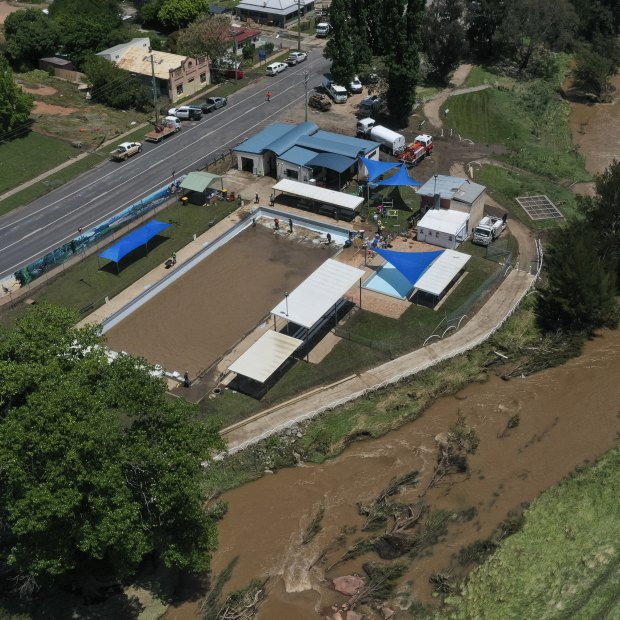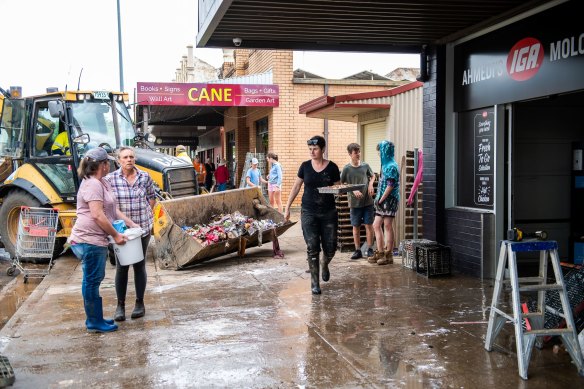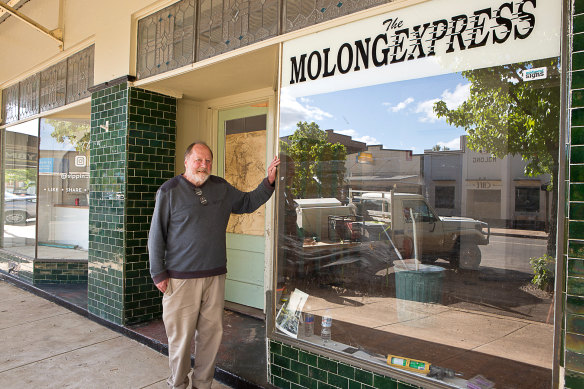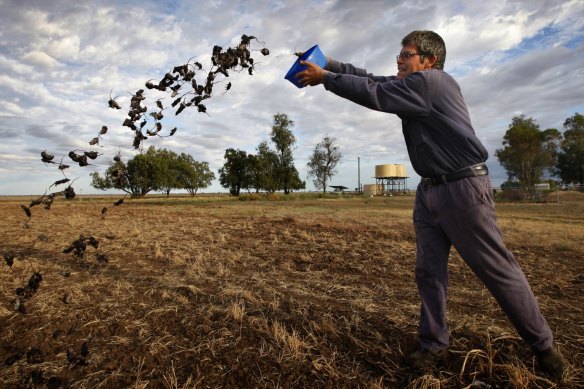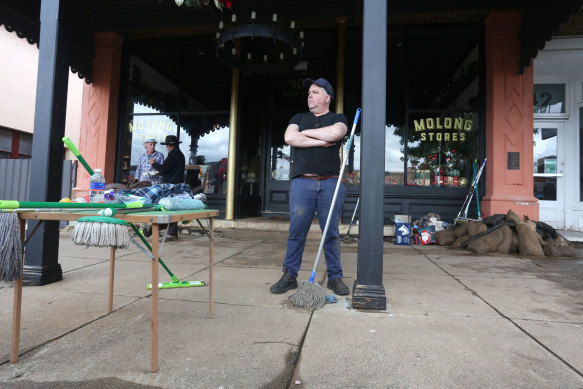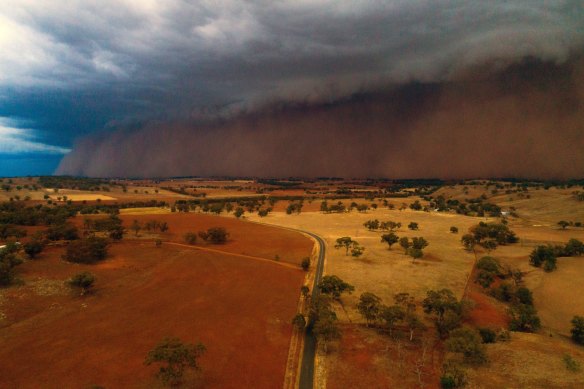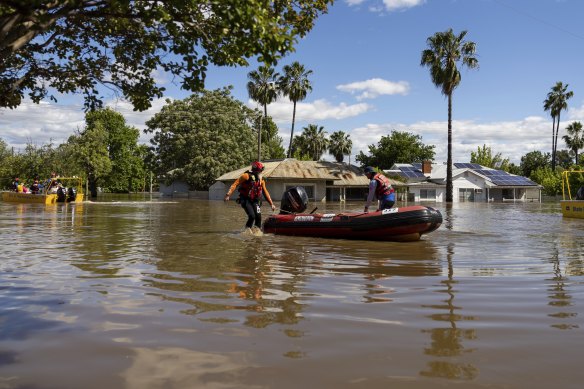By Laura Chung
Locals clean the Molong swimming pool. Credit:Rhett Wyman
Molong is the quintessential Australian town with historic buildings lining the main street that pay homage to its mining and agricultural roots. Like so many other picturesque country places in the Central West, its fortunes have been revived by a swarm of young people – many looking for a tree change – who have opened cafes and boutique gift shops. Tourism in the town boomed as people travelling through the region paused to stretch their legs and flicked through a copy of the weekly paper.
Soon it may become quintessential in another way. Recent research hints that the El Nino-La Nina weather patterns that govern heat and rainfall in the Pacific Ocean may be starting to dance to the drum of human-induced climate change. Towns like Molong – and its neighbours in the region – are already having to adjust to the new rhythm of extreme drought, flood and fire. Residents who remain will need to become models of resilience and survival on the climate change frontline. But for some, the never-ending cycle of extremes is already too much for them to bear.
Shop owners try to clean up after floodwaters swept through the town of Molong this week.Credit:Monique Lovick
This week, Molong and its neighbours have been put to the test, again. More than 100 millimetres of rain fell in 24 hours, adding more water to an already saturated landscape. The creek started to peak at 4.25 metres on Monday morning, sending more than a metre of water into the main street. Shops that had never flooded before had more than a metre of water flowing through them. The force of the raging water carried at least two shipping containers down the main street, lifted parked cars and knocked out the back wall of the supermarket.
Paul Mullins and his partner Rozzi Smith spent hours trapped on their kitchen bench as floodwaters rose around them. They were told the floodwaters were too strong for the SES to send in a boat. Instead, they watched 70 years worth of memories and belongings wash away. Mullins, who runs the local paper – The Molong Express – lost both his house and business in the floods.
As Monday morning broke, the water receded just as quickly as it came and the town saw the damage.
Paul Mullins, owner of the local paper, lost both the business and his home in the Molong floods this week.Credit:Robert Bruce
“The paper won’t be coming out this week,” Mullins jokes. “We’ve saved a few bits and pieces … but [the house] is an empty shell. But you get into a state of mind: ‘I could have gone under and lost my life’, so I don’t care about the stuff.”
Just three years ago, Molong’s water problems were very different. The town was running out of water, and it struck a deal to take some from nearby Orange. Aerial photos at the time show its local pool, filled with bore water, glistening with its blue tiles – as an out-of-place oasis in the middle of a brown, parched landscape. Dust storms would roll through the area, coating cars and shops in a deep red, and turning main streets into a scene from an apocalyptic movie.
Then, came the mice plague. At the time, Deputy Premier Paul Toole said: “Mother nature has thrown everything but the kitchen sink at farmers over the past few years – droughts, fires, floods, a mice plague – but they are the most resilient humans you’ll ever meet”.
For months last year, millions of mice destroyed thousands of crops.Credit:Dean Sewell
Now, large lakes of water surround the town, while nearby Eugowra, Cowra, Canowindra, Forbes and Parkes are also taking stock after back-to-back natural disasters over the past few years. Many residents agree: this event is the worst.
Cabonne mayor Kevin Beatty says words can’t describe the devastation his shire has seen, and he knows of people who will not be staying after this latest natural disaster. “You can’t blame them. It has been a traumatic experience. I know a lot of the community will bounce back, but there will be some that won’t bounce back, or can’t afford to,” he says.
Robert Carroll, who owns the Molong Store and lost a significant portion of his stock to this week’s floods, has lived in the Central West most of his life. He’s seen the ebb and flow of dry and wet. During the 2017-2019 drought, Carroll and his partner – like many Australians – were under severe water restrictions and keeping showers short, letting their garden die and reusing water whenever they could. People they knew were considering walking away from family farms because it seemed impossible to continue. There is no doubt in Carroll’s mind that the natural disasters over the past three years are being driven by climate change.
“All people out here are saying is that they are worried about another drought coming back. Is it going to be worth it? Are people going to lose their farms?” he says. “The weather is controlling our lives.”
Robert Carroll stands outside his shop in Molong after the flood had subsided.Credit:Steve Gosch
Australia is no stranger to weather extremes, swinging from intense drought to floods within a matter of months. NSW government data shows that most regions across the state have been under at least one natural disaster declaration since 2017. For example, areas such as Cabonne – which includes Molong and Eugowra, the Mid North Coast and Clarence Valley have all experienced nine declarations related to storms or floods. On the other end of the spectrum, Tamworth has the most natural disaster declarations related to bushfires between 2017 and 2022.
As climate change worsens, there is likely to be increased flooding in Australia. This is because warm air can hold more water than cold air. When that moisture turns to rain, it’s more likely to fall as an intense burst. In recent decades the intensity of extreme rainfall events has increased by about 10 per cent in some parts of Australia. The country is also likely to see increased and prolonged hot and dry periods.
Many communities hit by the latest natural disaster are grappling with what happens next. Rebuilding will bring challenges and many residents are largely uninsured, with flood insurance premiums at about $30,000 to $40,000 a year. Some will be looking to opt into a buyback scheme – similar to that announced in the days following the Lismore floods – in the hopes of starting afresh.
Former ACT Emergency Services Authority commissioner Peter Dunn says buyback schemes and relocating communities are just part of the solution. It’s also important to stop future floodplain developments and reduce emissions, as well as making communities more resilient by arming them with ample resources such as equipment, infrastructure and education.
He says communities across the country have shown time and time again that they are resilient, but there are only so many times they can bounce back, and climate change will put these communities to the test. Now, their challenge will be preserving their rich histories and preparing for the extremes of the future. This means communities will need to start ensuring infrastructure is dual purpose, he says. For example, every new cycle path built must also be an evacuation route, while a new building must also double as a fire refuge.
The Central West is no stranger to natural disasters – but this latest round of flooding may be too much for some communities.Credit:Nearmap
“[People moving away] starts to destroy the history and the agricultural centres suddenly collapse and then we’ve got nothing there,” he says.
Dunn experienced the 2003 Canberra and the Black Summer bushfires, and said the thought of dealing with another natural disaster was just too much. He has been part of a growing portion of the population moving away from the endless cycle of disasters. Dunn now calls the NSW coastal community of Tuross Head home.
Director of the Institute for Climate, Energy and Disaster Solutions at the Australian National University Professor Mark Howden says climate change is embedded in the natural disasters that have affected the country in the past three years – although its role in the most recent floods is yet to be determined. This growing field of research, known as “event attribution”, is blossoming as scientists work to link disasters to a warming climate. For heat extremes, this is fairly straightforward but determining how it impacts flooding is a bit more complex.
Howden says climate change has made La Nina and El Nino more extreme.
The long-term records of El Nino and La Nina weather patterns do show greater variability in recent decades, with a tendency for more events clustered together. But there have been fluctuations in the pre-industrial era too. The possible links between changes to El Nino and La Nina are at the cutting edge of climate science, so scientists are still treating findings with caution. However, the science agrees that extreme weather events will become more frequent and intense in the future.
Just three years ago, the region was battling drought, fires and dust storms.Credit:Nick Moir
“We can say they are already being driven by climate change with a fair degree of confidence,” Howden says. “My level of concern with climate change is higher than it has ever been because the science is clearer than it has ever been.”
“At the same time, efforts to reduce emissions and adapt to those changes are not occurring at the same rate and scale of change … But these challenges are not insurmountable, they are actually manageable. We have many of the tools and the understandings needed to deal with it.”
The Central West town of Forbes has been under major flooding conditions this week, with waters just starting to recede.Credit:Alex Ellinghausen
The costs associated with climate change cannot be ignored either. Under 2 degrees of warming, Australia’s economy would miss out on $115 billion in lost earnings over the next decade and $350 billion over the next 20 years, the Intergovernmental Panel on Climate Change (IPCC) report in March found. Under 3 degrees warming, the economy would lose $200 billion in potential earnings by 2032 and $600 billion by 2042. The report also says it has ever higher confidence in predicting “compounding and cascading” effects of climate change.
The world has already heated by 1.1 degrees and Australia’s land mass has warmed by an average of 1.4 degrees since 1910, according to the CSIRO.
Ultimately, the greatest asset these towns may have in their fight to stay alive may be their enduring community spirit. NSW RFS aviation rescue crewman Tim Perry, who grew up in Eugowra and now lives in Forbes, has spent the last week rescuing people from a helicopter in the Central West region. He knows many of the people he’s wrenched to safety and says it has been surreal seeing where he grew up transformed into an ocean. Despite battling fires, floods and drought, Perry is determined to stay. “This area is home, I won’t leave,” he says.
For Mullins, the community spirit drives him to fight to keep his local paper alive. “I’ll find one way or another [to keep it going], he says. ” I don’t know how or where, every day it changes. Even the RSL club offered me their office to run it out of. We will work something out.”
The Morning Edition newsletter is our guide to the day’s most important and interesting stories, analysis and insights. Sign up here.
Most Viewed in Environment
Source: Read Full Article
